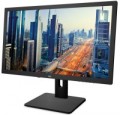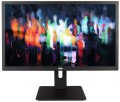Size
Diagonal size of the monitor matrix, in inches.
This parameter is one of the most important for any screen — it determines the total size of its working area. In general, it is believed that larger monitors are more comfortable: a large screen allows you to see a large fragment of text, images, etc. without having to scroll the "picture". On the other hand, the diagonal directly affects the dimensions, weight and cost of the monitor. In addition, it is worth remembering that screens with the same diagonal can have different aspect ratios and different specializations: for example, widescreen models are convenient for playing games and watching movies, while classic
4:3 or 5:4 solutions are preferable for working with documents. Now there are monitors of different diagonals on the market, among them the most popular are:
19–20",
22",
23 – 24",
25 – 26",
27 – 28",
29 – 30",
32",
34" and
more.
Dynamic Contrast
Dynamic contrast provided by the monitor screen.
Dynamic contrast refers to the difference between the brightest white at maximum backlight intensity and the deepest black at minimum backlight. In this way, this indicator differs from static contrast, which is indicated with a constant backlight level (see above). Dynamic contrast ratio can be expressed in very impressive numbers (in some models — more than 100,000,000: 1). However, in fact, these figures are poorly correlated with what the viewer sees: it is almost impossible to achieve such a difference within one frame. Therefore, dynamic contrast is most often more of an advertising than a practically significant indicator, it is often indicated precisely in order to impress an inexperienced buyer. At the same time, we note that there are "smart" backlight technologies that allow you to change its brightness in certain areas of the screen and achieve a higher contrast in one frame than the claimed static one; these technologies are found mostly in premium monitors.
Colour depth
The colour depth supported by the monitor.
This parameter characterizes the number of shades that the screen can display. And here it is worth recalling that the image in modern monitors is based on 3 basic colours — red, green, blue (RGB scheme). And the number of bits is indicated not for the entire screen, but for each base colour. For example, 6 bits (the minimum colour depth for modern monitors) means that the screen is capable of producing 2 ^ 6, that is, 64 shades of red, green and blue; the total number of shades will be 64 * 64 * 64 = 262,144 (0.26 million). An
8-bit colour depth (256 shades for each base colour) already gives a total of 16.7 million colours; and the most advanced modern monitors support
10-bit colour, allowing you to work with more than a billion shades.
Screens with support for FRC technology are worth a special mention; nowadays, you can find models marked "
6 bit + FRC " and "
8 bit + FRC ". This technology was developed to improve picture quality in situations where the incoming video signal has a greater colour depth than the screen, such as when 10-bit video is fed to an 8-bit matrix. If such a screen supports FRC, the picture on it will be noticeably better than on a regular 8-bit monitor (although somewhat worse than on a full-fledged 10-bit monitor, but “8 bit + FRC” screens are much
...cheaper).
High colour depth is important primarily for professional graphics and other tasks that require high colour fidelity. On the other hand, such features significantly affect the cost of the monitor. In addition, it is worth remembering that the quality of colour reproduction depends not only on the colour depth, but also on other parameters — in particular, colour gamut (see below).Connectors (optional)
—
Mini-Jack input (3.5 mm). Audio input with standard 3.5mm mini-jack. Usually, it looks like a socket into which a mini-jack plug is connected from a signal source. The signal itself from such an input can be fed either to the monitor's built-in speakers or to the audio output (see below for both).
—
Mini-Jack output (3.5 mm). Analogue audio output using a standard 3.5mm mini-jack. Usually it is universal, it can be used both for connecting headphones and as a
line output for computer speakers or other active acoustics. The presence of an audio jack on the monitor is convenient because such a port is usually closer to the user than the audio card outputs, and connecting headphones or speakers directly to the monitor is easier than pulling a wire to the system unit.
-LAN. Standard connector for wired connection to computer networks. The presence of such an input in most cases turns the monitor into a network device: any network user with the appropriate access rights can display an image on it. Another use case for LAN is a direct connection to another device. For example, in this way you can connect a laptop with a LAN output without disconnecting the monitor from the PC (to which it can be connected, for example, via the DVI interface). And some especially advanced models have embedded software tools that allow using t
...he local network to view the contents of devices connected to this network, and even use some web services directly from the monitor, without using a computer as such.
— Composite. One of the simplest and most common analogue audio/video inputs. Like component, it uses three wires and in its standard form consists of three RCA connectors; in some monitors, both interfaces can even be implemented through one set of connectors, switched to "component" or "composite" modes in the settings. The peculiarity of this standard is that it allows you to transmit both picture and sound: one of the wires is used for the analogue video signal, and the remaining two are responsible for the left and right stereo channels. However the composite interface is considered outdated: due to video transmission over a single cable, the quality and noise immunity of the picture are low, and there is no talk of HD resolutions at all. On the other hand, such outputs are still quite popular in video technology — both modern and frankly outdated (like VHS VCRs). And the ability to connect both video and sound at once is very convenient. However, if the monitor has neither audio outputs nor built-in speakers, it usually provides a stripped-down version of this connector — "composite video", with one RCA jack.
— Coaxial (S/P-DIF). An electrical version of the S / P-DIF interface: through one coaxial RCA connector (tulip), sound is transmitted digitally, including multichannel. This connector is found mainly among large-format plasma and LCD panels (see "Type"), where it plays the role of an output for connecting external audio systems — primarily home theaters and other advanced multi-channel acoustic sets.
— Linear. The line interface is a standard audio interface for transmitting an audio signal in analogue format. In general, the most popular way to use this connector is to output sound to active speakers and/or an external amplifier. However, monitors can have both outputs and inputs of this type. In this sense, the line interface is similar to the 3.5 mm jack described above; moreover, in some models, the mini-Jack plays the role of a linear connector.
— Optical. Another type of S / P-DIF connector, in addition to the coaxial output described above. It is used for the same purpose — to output multi-channel sound to external acoustics — however, it uses not an electrical, but an optical (light-guide) cable, so that such a connection is absolutely not subject to electrical interference. On the other hand, optical fibre requires careful handling, as it can crack from bending or strong pressure. It is also worth noting that, unlike coaxial, the optical output is found in both large and relatively small monitors.
— COM port (RS-232). Universal digital interface for transferring various data. In monitors, it usually plays an auxiliary role: it allows you to control the screen settings from a connected computer or other device, and in models with touch screens it can also be used to transfer data from the sensor to the computer. It is much less common than USB, it is practically not used in laptops, but it has the advantage of a maximum cable length — 15 m versus 5 m.Sound power
Rated power of the speakers installed in the monitor (see "Built-in speakers"). The higher the power, the louder the acoustics can sound, the easier it is to cover a vast space. However, in most cases, the user is directly in front of the monitor, and high volume is not required for normal hearing. So this parameter is critical mainly for plasma and LCD panels (see "Type").
USB hub 2.0
a
USB hub 2.0 is a set of additional USB ports on the monitor case, to which you can connect various peripherals (provided that the monitor is connected to the computer's USB port with a special cable). This equipment performs two useful functions. First, the hub increases the number of ports available for connection. Secondly, these connectors are located in close proximity to the user, literally at arm's length. However note that splitters are not well suited for connecting devices that require a lot of power via USB (for example, external hard drives without a separate power supply). This is due to the fact that the splitter “divides” the power coming from the computer port equally to all connected devices, and with a “loaded” hub, the power may not be enough at one moment.
Also note that the 2.0 standard is characterized by a bandwidth of 480 Mbps and has long been considered obsolete, but monitors with this interface are still being produced.
Power consumption
Rated power consumption of the monitor. Usually, this item indicates the maximum power that the device can consume during normal operation — that is, the energy consumption at maximum brightness, the highest volume of the built-in acoustics, etc. Actual power consumption can be noticeably lower, however, when choosing, it is still best to focus on the value stated in the specifications.
In general, the lower the power consumption, the more economical the device in terms of electricity consumption (ceteris paribus). In addition, this characteristic can be useful when selecting an uninterruptible power supply for a PC and in other specific situations when it is necessary to accurately determine the power consumption of equipment.

